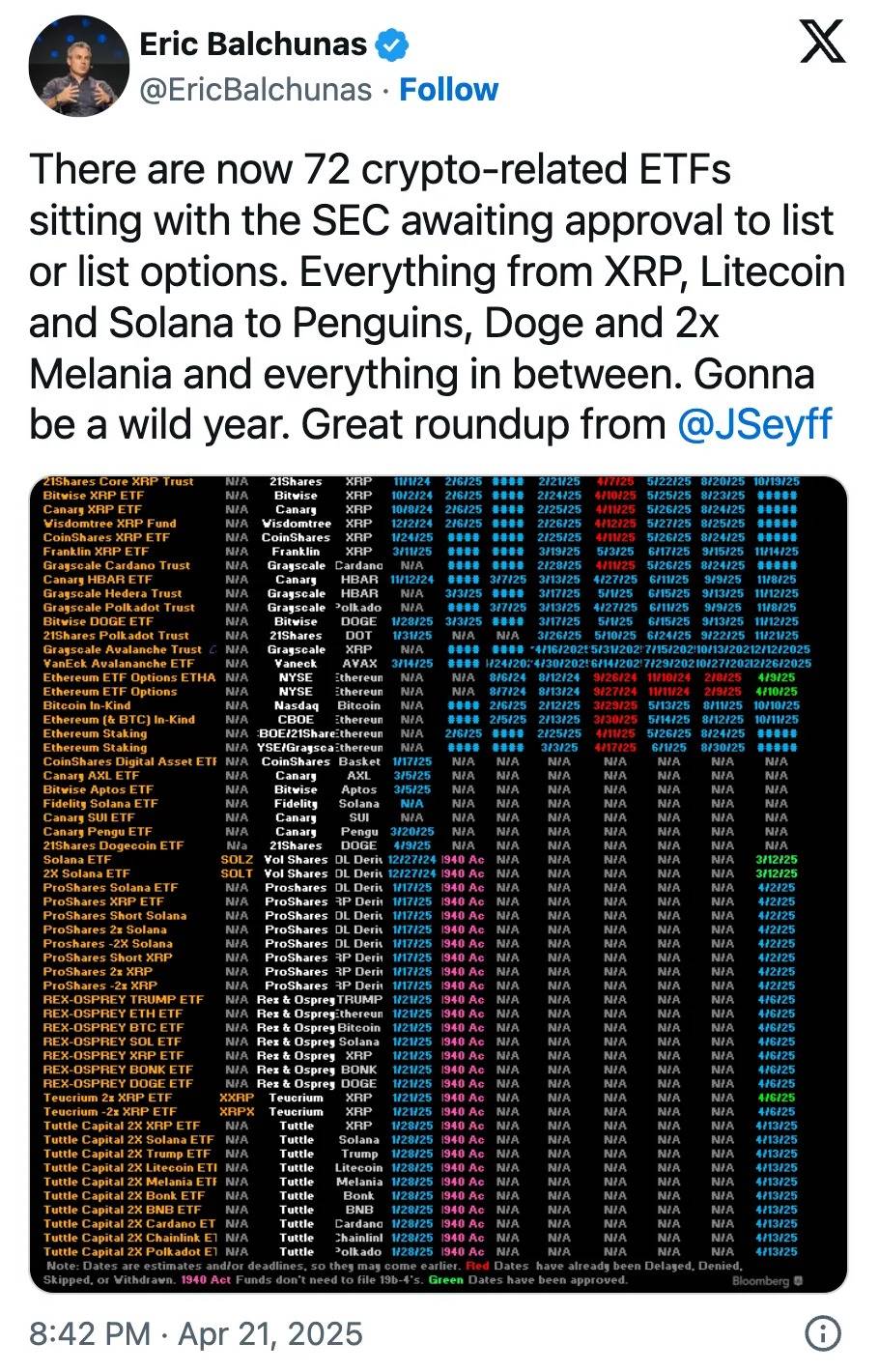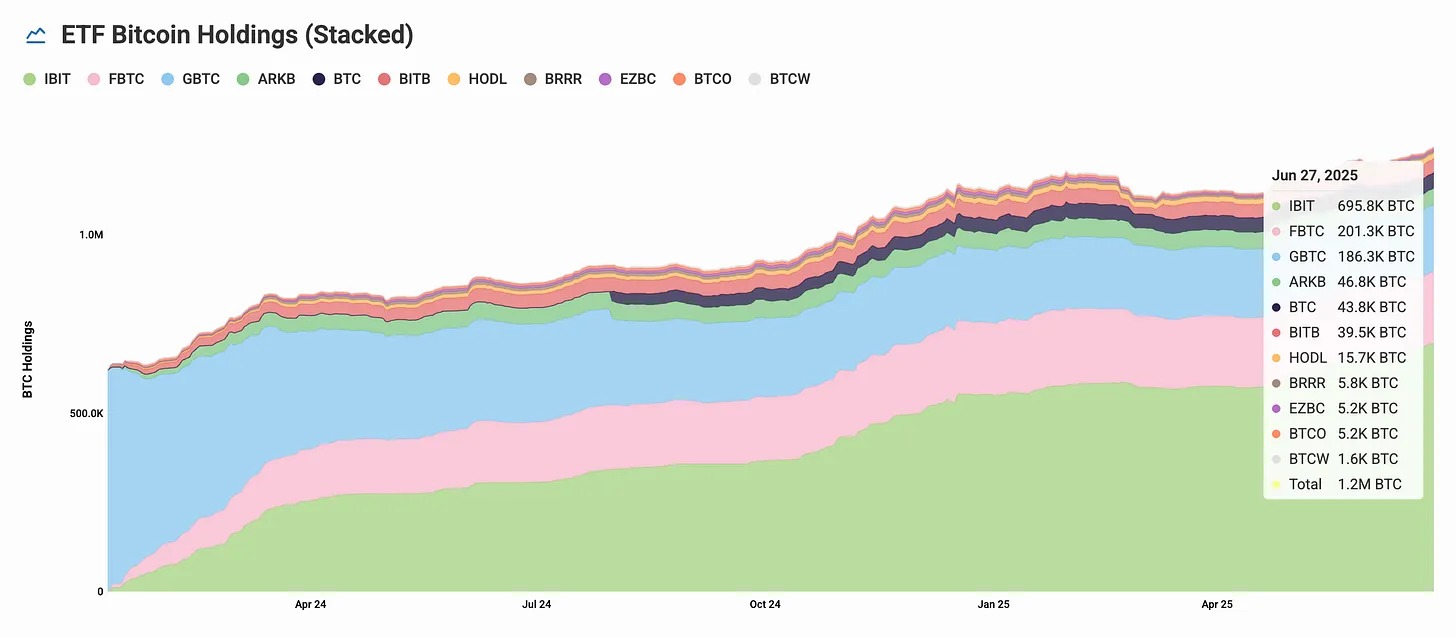The surge of altcoin ETFs is changing the logic of cryptocurrency investment.
Written by: Thejaswini MA
Translated by: AididiaoJP, Foresight News
Does this create real value, or is it merely speculation dressed in the guise of regulatory approval?
January 2024 feels like a lifetime ago. Although only 18 months have passed, it seems like a century. This period has been an epic journey for cryptocurrencies.
On January 11, 2024, the spot Bitcoin ETF landed on Wall Street. About six months later, on July 23, the Ethereum ETF also took the stage. Today, the U.S. Securities and Exchange Commission (SEC) is inundated with 72 applications for crypto ETFs, and the number continues to grow.

From Solana to Dogecoin, from XRP to Pudgy Penguins, asset management firms are packaging various digital assets into compliant financial products. Bloomberg analysts Eric Balchunas and James Seyffart have raised the approval probability of these applications to "over 90%," indicating that we are about to witness the largest expansion of crypto investment products in history.
If 2024 is a breakout year for survival, then 2025 will be the harvest time for the competition.
The $107 billion Feast of Bitcoin ETFs
To understand the significance of altcoin ETFs, one must first recognize how the Bitcoin spot ETF has upended everyone's expectations and rewritten the rules of the asset management industry.
In just one year, the Bitcoin ETF attracted $107 billion, becoming the most successful ETF launch in history, and today, 18 months later, its assets under management have reached $133 billion.
BlackRock's IBIT alone holds 694,400 Bitcoins, valued at over $74 billion. All Bitcoin ETFs combined control 1.23 million Bitcoins, accounting for about 6.2% of the total circulating supply.

When BlackRock's Bitcoin ETF surpassed $70 billion in assets at the fastest pace ever, it proved that the demand for traditional investment tools to gain exposure to crypto is real, substantial, and far from saturated. Institutions and retail investors are all lining up to enter.
This success has created a virtuous cycle: ETF accumulation leads to a decrease in Bitcoin balances on exchanges, institutional holdings accelerate growth, Bitcoin price stability improves, and the entire crypto market gains unprecedented compliance. Even amid market volatility, institutional funds continue to flow in. These are not day traders or retail speculators, but pension funds, family offices, and sovereign wealth funds that view Bitcoin as a legitimate asset class.
It is this success that has led to approximately 72 altcoin ETF applications piling up at the SEC as of April.
What is the value of ETFs?
Since altcoins can be purchased directly on exchanges, what is the use of ETFs? This is precisely the market logic surrounding mainstream acceptance. ETFs are a milestone for cryptocurrencies.

They grant digital assets the legitimacy to trade on traditional stock exchanges, allowing investors to buy and sell crypto assets through regular securities accounts. For most ordinary investors unfamiliar with crypto technology, this is a lifesaver. There is no need to set up wallets, manage private keys, or deal with the technical details of blockchain. Even if the wallet barrier is overcome, risks such as hacking, lost private keys, and exchange failures loom large. ETFs represent a solution for investors to manage custody and security issues, providing high liquidity assets that circulate on mainstream exchanges.
The Altcoin Gold Rush
The application list reveals the upcoming diversity of compliant crypto assets. Giants like VanEck, Grayscale, Bitwise, and Franklin Templeton have submitted applications for Solana ETFs, with a 90% approval probability. Nine institutions, including newcomer Invesco Galaxy (proposing the code QSOL), are vying for the SOL pie.
XRP follows closely behind, with multiple applications targeting this payment token. ETFs for Cardano, Litecoin, and Avalanche are also in the review process.
Even meme coins have not escaped. Mainstream issuers have submitted applications for Dogecoin and PENGU ETFs. "Surprisingly, no one has applied for a Fartcoin ETF," Bloomberg's Eric Balchunas joked on X platform.
Why is there a concentrated explosion at this moment? This is the result of multiple factors resonating together. The pro-crypto policies of the Trump administration marked a regulatory shift, and the new SEC Chairman Paul Atkins abolished Gary Gensler's "enforcement over regulation" approach, establishing a crypto working group to formulate clear rules.
The regulatory thaw reached a climax in the SEC's latest statement, declaring that "protocol staking activities" do not constitute securities issuance, completely changing the previous administration's crackdown on staking service providers like Kraken and Coinbase.
With Bitcoin and altcoins gaining institutional certification, coupled with the corporate crypto reserve craze and Bitwise research showing that 56% of financial advisors are willing to allocate crypto assets, a diversified demand for crypto exposure beyond Bitcoin and Ethereum has emerged.
Demand Validation
While the Bitcoin ETF has proven the authenticity of institutional demand, early analyses indicate that altcoin ETFs will face a distinctly different situation.
Katalin Tischhauser, head of research at Sygnum Bank, estimates that the total inflow for altcoin ETFs will be "hundreds of millions to $1 billion," a mere fraction of Bitcoin's $107 billion scale.
Even the most optimistic estimates show that the total scale of altcoin ETFs is unlikely to reach even 1% of Bitcoin's. From a fundamental perspective, this difference is reasonable.
The comparison with Ethereum is even more brutal. As the second-largest cryptocurrency, the Ethereum ETF attracted only about $4 billion in net inflows over 231 trading days, barely reaching 3% of Bitcoin's $133 billion scale. Despite a recent $1 billion inflow over 15 trading days, Ethereum's institutional appeal remains far inferior to Bitcoin, indicating that altcoin ETFs will face a more severe battle for investor attention.
Bitcoin has won institutional favor due to its first-mover advantage, regulatory clarity, and the straightforward narrative of "digital gold." Now, 72 applications are competing for a market that may only accommodate a few winners.
Staking Rewrites the Rules
One key factor that may differentiate altcoin ETFs from Bitcoin products is the income generated through staking. The SEC's easing of staking regulations opens new possibilities for ETFs, allowing for staking positions and distributing rewards to investors.
Currently, Ethereum staking offers an annualized yield of about 2.5-2.7%. After deducting ETF fees and operating costs, investors may receive a net yield of 1.9-2.2%, which may seem modest by traditional fixed-income standards, but is quite attractive when combined with potential price appreciation.
Solana staking also provides similar opportunities. This creates a new profit model for ETF issuers and offers new value to investors. ETFs with staking capabilities are no longer just price exposure tools but become revenue-generating assets that can produce passive income.
Multiple Solana ETF applications explicitly include staking provisions, with issuers planning to stake 50-70% of their holdings while maintaining liquidity reserves. The Invesco Galaxy Solana ETF application specifically mentions using "trusted staking service providers" to generate additional income.
However, staking also brings operational complexities. ETF managers managing staked crypto assets face multiple challenges: they must maintain sufficient non-staked assets to handle redemptions while maximizing the staking ratio to increase yields; they also need to manage "slashing" risks, where funds may be lost if validators make mistakes or violate rules. Operating validation nodes requires specialized technology and reliable infrastructure. Therefore, successfully operating a crypto ETF with staked assets is akin to walking a tightrope; while not impossible, it is extremely challenging.
Previously approved Bitcoin and Ethereum ETFs did not have this option, as the SEC under Gary Gensler deemed staking to violate securities laws, constituting unregistered securities issuance.
Fee Wars
The 72 applications will inevitably trigger a fee war. When numerous products compete for limited institutional funds, price becomes a key differentiator. Traditional crypto ETF management fees range from 0.15% to 1.5%, but competition may drive them even lower.
Some issuers may even subsidize management fees with staking income, launching zero-fee or negative-fee products to attract funds. The Canadian market has already seen several Solana ETFs introduced with limited-time management fee waivers.
This fee compression benefits investors but squeezes profit margins for issuers. Only the largest and most efficient operators will survive. Mergers, exits, and transformations are expected, and the market will ultimately determine the winners.
Perspective
The altcoin ETF craze is changing the logic of crypto investment.
The Bitcoin ETF has been a resounding success. The Ethereum ETF provided a second option, but its complexity and lackluster returns have led to a tepid response. Now, asset management firms are betting on different cryptocurrencies, each with its strengths.
Solana emphasizes speed, XRP focuses on payment scenarios, Cardano touts "academic rigor," and even Dogecoin is telling a mainstream acceptance story. This is indeed meaningful for building investment portfolios. Cryptocurrencies are no longer an alternative asset class but have diversified into dozens of investment targets with varying risk characteristics and use cases.
As the largest cryptocurrency by market capitalization, Bitcoin has become an extension of many stock market investors' traditional portfolios, providing risk diversification and serving as a hedge against market uncertainty. In contrast, Ethereum, while second, has not achieved the same level of mainstream integration, and most retail and institutional investors do not view the Ethereum ETF as a core allocation.
Altcoin ETFs need to provide differentiated value to avoid repeating the fate of the Ethereum ETF.
But this also reflects how the crypto industry has drifted away from its original intentions. When even meme coins have ETF applications, when 72 products compete for attention, and when fee compression resembles a commodity business, this industry has become thoroughly mainstream.
The question is: does this create real value, or is it merely speculation dressed in the guise of regulatory approval? The answer may depend on perspective. Asset management firms see a new source of income in a crowded market, while investors can easily gain crypto exposure through familiar products.
The market will ultimately render its judgment.
免责声明:本文章仅代表作者个人观点,不代表本平台的立场和观点。本文章仅供信息分享,不构成对任何人的任何投资建议。用户与作者之间的任何争议,与本平台无关。如网页中刊载的文章或图片涉及侵权,请提供相关的权利证明和身份证明发送邮件到support@aicoin.com,本平台相关工作人员将会进行核查。




